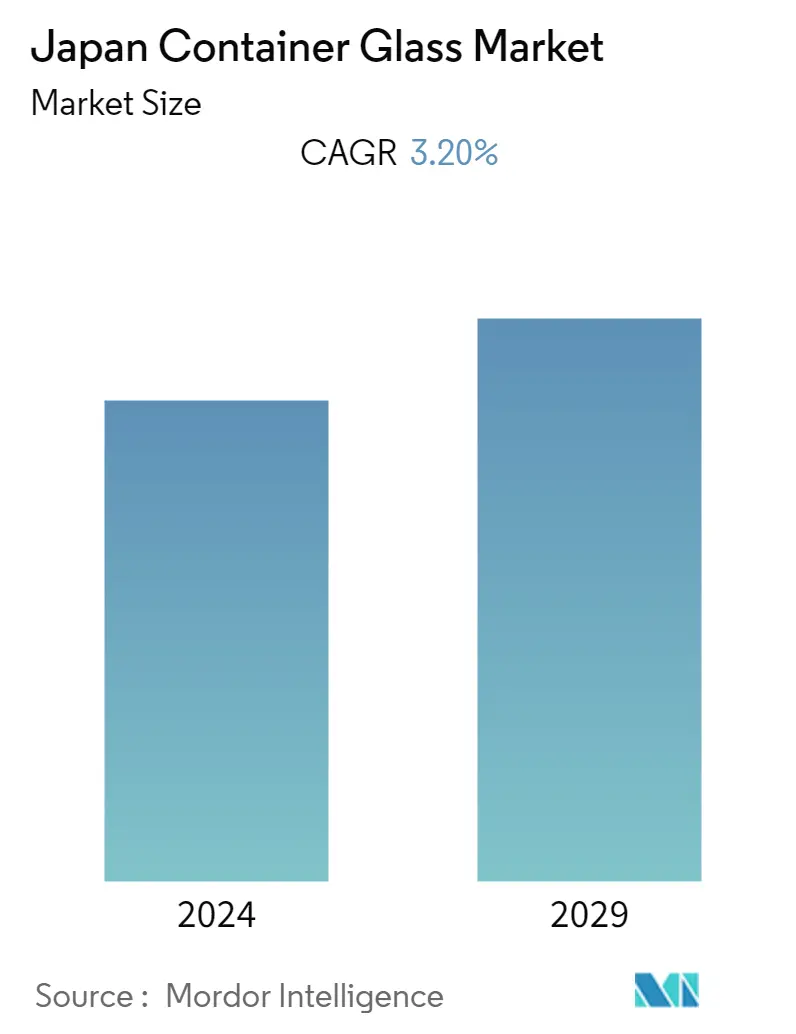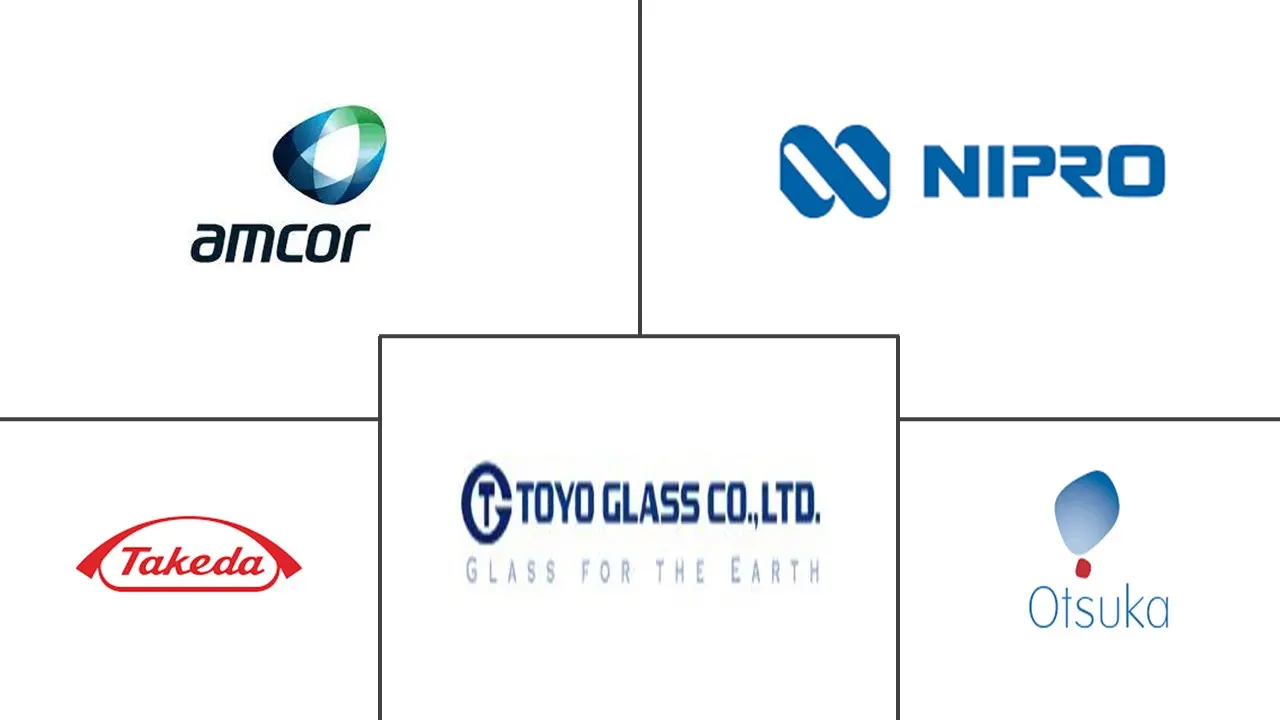Market Size of Japan Container Glass Industry

| Study Period | 2019 - 2029 |
| Base Year For Estimation | 2023 |
| Forecast Data Period | 2024 - 2029 |
| Historical Data Period | 2019 - 2022 |
| CAGR | 3.20 % |
| Market Concentration | Medium |
Major Players
*Disclaimer: Major Players sorted in no particular order |
Japan Container Glass Market Analysis
The Japan Container Glass Market is expected to register a CAGR of 3.2% during the forecast period (2020 - 2027). The demand for glass containers is increasing due to various advantages such as infinitely reusable, recyclable, refillable, and increasing acceptance in multiple industries, which are the key factors driving the market growth.
- The demand for healthier and safer packaging is driving the country's container glass industry. New shapes, aesthetic improvements, and embossing make the packaging more appealing to the end consumer. Glass packaging is growing due to the need for biodegradable and environmentally friendly products and the rise of the food and beverage market.
- Japanese beverage containers are primarily made of glass bottles, the beverage industry still operates effective bottle recycling systems. Also, the problem of waste and global warming progresses, glass containers are driving the market.
- According to Mainichi News 2021, 23 Japanese companies, from food to cosmetics, will join an initiative to collect and reuse containers to reduce plastic waste. The companies focus on glass containers that are easy to reuse with a simple design that gives a sense of unity, making a clear distinction from ordinary retail products. Such initiatives ny the organizations drive the glass container market in the country.
- However, glass production requires an excess of thermal energy and the release of the raw material CO2 during the melting process. Commercial glass containers are not easy to recycle. Various efforts have been made in the Japanese glass industry to reduce glass's environmental impact, which can hinder the market's growth.
- Covid-19 pandemic impacted companies negatively with the shutdown of manufacturing plants across the country. But, lockdown measures during the COVID-19 pandemic led to a surge in demand for home delivery and take-out services. The use of glass bottles and cans from home increased during the pandemic.
Japan Container Glass Industry Segmentation
Glass Containers refer to clean bottles and jars, among others products type made from clear glass. The scope excludes windows and other non-container glass, porcelain and ceramic products.
Japan Container Glass Market is segmented By End-User Industry (Beverage, (Alcoholic and Non-Alcoholic), Food, Cosmetics, Pharmaceuticals)
| End-User Industry | ||||
| ||||
| Food | ||||
| Cosmetics | ||||
| Pharmaceuticals | ||||
| Other End user verticals |
Japan Container Glass Market Size Summary
The Japan Container Glass Market is experiencing growth driven by the increasing demand for sustainable and environmentally friendly packaging solutions. The market benefits from the inherent advantages of glass, such as its recyclability and reusability, which align with the rising consumer preference for biodegradable products. The beverage industry, in particular, is a significant contributor to this demand, with glass bottles being the preferred choice due to their ability to preserve product quality. Initiatives by Japanese companies to reduce plastic waste by promoting glass container reuse further bolster market expansion. Despite challenges such as the energy-intensive nature of glass production and the complexities of recycling, the market continues to thrive, supported by strong recycling infrastructure and government regulations aimed at reducing plastic usage.
The pharmaceutical sector in Japan also plays a crucial role in the container glass market's growth, with increasing demand for glass packaging solutions for pharmaceuticals. Companies are expanding their production capabilities to meet this demand, as evidenced by investments in new glass packaging facilities. The market is moderately fragmented, with key players focusing on innovation and strategic collaborations to enhance their market presence. Additionally, the growing consumption of wine and the preference for glass packaging in the alcoholic beverage sector contribute to the market's positive outlook. Government policies and international trade agreements further support the use of glass containers, reinforcing the market's trajectory towards sustainable packaging solutions.
Japan Container Glass Market Size - Table of Contents
-
1. MARKET DYNAMICS
-
1.1 Market Drivers
-
1.1.1 Growing Demand for Environmentally Friendly and Reusable Products
-
1.1.2 Increased Demand in the Food and Beverage Market
-
-
1.2 Market Restrain
-
1.2.1 Glass Production is Energy Intensive with High Temperatures for Manufacturing
-
-
-
2. MARKET SEGMENTATION
-
2.1 End-User Industry
-
2.1.1 Beverage
-
2.1.1.1 Alcoholic
-
2.1.1.2 Non-Alcoholic
-
-
2.1.2 Food
-
2.1.3 Cosmetics
-
2.1.4 Pharmaceuticals
-
2.1.5 Other End user verticals
-
-
Japan Container Glass Market Size FAQs
What is the current Japan Container Glass Market size?
The Japan Container Glass Market is projected to register a CAGR of 3.20% during the forecast period (2024-2029)
Who are the key players in Japan Container Glass Market?
Takeda Pharmaceutical Company Limited, Nipro Corporation, Ostsuka Pharmaceutical Co., Ltd, Amcor PLC and Toyo Glass Co., Ltd. are the major companies operating in the Japan Container Glass Market.

